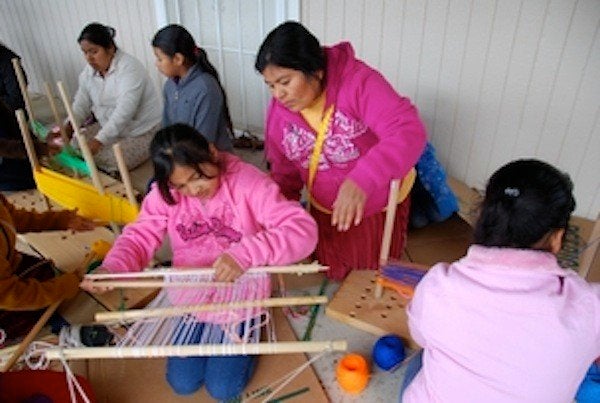
This article comes to us courtesy of California Watch.
Before she died last month at age 70, the respected Pomo basket weaver and activist Luwana Quitiquit was asked by a researcher for her personal definition of wellness.
“Storytelling is wellness,” she said. “And the reason it is wellness for my family is because it puts my kids back in touch with my grandmother, of people they never get to see. It inspires them to carry on their culture. That’s wellness.”
The link between traditional artistic practices and mental and physical health is explored in “Weaving Traditional Arts Into the Fabric of Community Health,” a study [PDF] by the UC Davis Center for Reducing Health Disparities. The report was commissioned by the Alliance for California Traditional Arts, a nonprofit in Fresno that provides support for folk and traditional artists, the majority of whom are immigrants and Native Americans. In these often-overlooked minority communities, the arts tend to be passed down from one generation to another as collective wisdom, rather than as a personal statement.
“Part of what makes a healthy community is having a vibrant cultural life,” said Amy Kitchener, executive director of the Alliance for California Traditional Arts. “Native Americans have always made a strong connection between cultural practices and health. Unlike the western idea of art in a gallery, for traditional artists, it is embedded in everyday life, in ceremonies and family rites of passage. But objectively evaluating the impact of the arts on health is challenging.”
The study, published in October, was based on a non-scientific hunch: that immigrants and others who maintain and cultivate their traditional cultural practices reap positive health benefits. The alliance, founded in 1997, provides grants and apprenticeships to “tradition-bearers” – the state’s living cultural treasures, many of them elderly, as well as organizations that help foster traditional arts. Among their eclectic ranks are Yurok dugout canoe makers, Persian drummers, Laotian textile embroiderers, Spanish flamenco dancers and an annual Polynesian fire knife dance competition in Anaheim sponsored by Fire Knife of Samoa, a group founded to preserve and perpetuate Pacific Island culture.
Not surprisingly, perhaps, interviews by UC Davis researchers revealed that the practice of traditional arts has manifold positive effects: contributing to spiritual and emotional growth; physical vigor; strengthening of personal and community identity; and mitigation of historical trauma, especially for Native Americans and refugees. The arts also provide a welcome distraction from illness and an enhanced respect for elders.
The preliminary findings echo those of a 1996 UC Davis mental health study of the Mexican population in Fresno, said Dr. Sergio Aguilar-Gaxiola, director of the university’s Center for Reducing Health Disparities. That study found a strong correlation between acculturation and mental health, with second-generation children of Mexican origin born in the U.S. having higher rates of mental disorders and alcohol and drug dependency than their Mexican-born parents.
“People who were more assimilated into the mainstream, in terms of language, the types of television and radio they listen to and so forth, tended to have worse mental health patterns,” Aguilar-Gaxiola said. “Those born in Mexico who remained identified with their language and traditions tended to have better mental health.”
Hugo Morales, founder of Radio Bilingüe, the country’s only public, non-commercial Spanish-language radio network, has called this phenomenon the “culture cure.” The California study is part of a broader national research effort to further examine the social determinants of health.
In Washington, D.C., for instance, the National Endowment for the Arts recently announced the formation of a federal interagency task force to investigate the effect of the arts on quality of life throughout a person’s lifespan. The initiative, a partnership with the U.S. Department of Health & Human Services, focuses on the arts as “part of the portfolio for a community,” said Sunil Iyengar, the endowment’s director of research and analysis.
“We’re moving away from a narrow, rabbit-hole definition of the arts toward the human development side,” he said. “We’re looking at the impact on well-being and social cohesion – values that resonate.”
Aguilar-Gaxiola of UC Davis called the preliminary study of California traditional artists “heartening.”
“It taps into what we identify as protective factors, especially in terms of intergenerational relationships, “ he said. If the lessons of the study “could be replicated and disseminated,” he added, “it could potentially reverse a lot of strains.”
Above all, dance, song, storytelling and other traditional art forms bring people together, fostering resilience, Kitchener notes. ”When you identify with community, you’re not alone,” she said. “That’s a basic human need.”
California Lost is an occasional series examining challenges facing neglected communities around the state. Patricia Leigh Brown is an investigative reporter for California Watch, a project of the nonprofit Center for Investigative Reporting. Find more California Watch stories here.